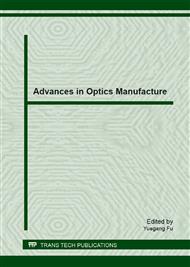p.115
p.124
p.131
p.137
p.142
p.147
p.152
p.158
p.162
Ion Beam Figuring Fabricate Effect with Different Removal Sizes
Abstract:
Ion Beam Figure (IBF) is believed to be one of the most effective technics that can fabricate lens with nano or even sub-nano accuracy. For different sizes of IBF removal functions, the correct effects in different spatial frequency range are different. Power Spectral Density (PSD) curve can describe surface errors in full spatial frequency range, so it is a very convenient way to evaluate the quality of lens’ surface. In this paper, firstly, the principles of IBF and PSD are introduced briefly; Secondly, IBF removal functions with sizes from 2 mm to 15 mm are generated. A lens with surface error more than PV value 400nm is simulated with different sizes of IBF removal functions by Lucy-Richardson algorithm. Finally, experiments are done by IBF plant. A lens is fabricated by different sizes of removal functions and the fabricate results are tested by interferometer precisely and calculated to PSD curves. By the comparison of these curves, the IBF fabricate effects with different removal sizes are analyzed, which show that the smaller the removal size, the better the removal effect in higher spatial frequency range, but in the meantime, it will take a much longer time. Also the reasons of the difference between theory simulation and actual fabrication result are taken into account, and several influence factors are analyzed.
Info:
Periodical:
Pages:
142-146
Citation:
Online since:
May 2013
Authors:
Keywords:
Price:
Сopyright:
© 2013 Trans Tech Publications Ltd. All Rights Reserved
Share:
Citation:


